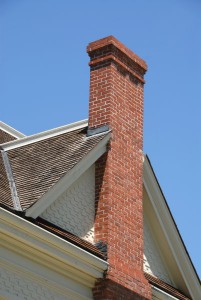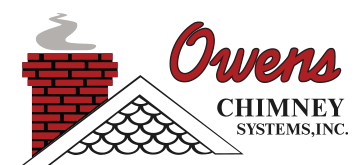Chimneys are far more complex than you may believe at first glance. The average homeowner is only vaguely familiar with the fireplace and/or chimney components that extend beyond the hearth and firebox. Knowing about these parts and their general functions can be useful as far as general maintenance is concerned, as well as being able to troubleshoot or even talk with one of our fireplace and chimney experts about your service. Keep reading to get better prepared for your next annual chimney inspection.

If you are familiar with the parts of your chimney, you’ll be able to spot problems and know what to do right away.
What are the parts of the chimney?
The flue is the passageway for smoke and fumes. Your flue liner provides a barrier that helps contain smoke, fumes and soot so they aren’t absorbed into the masonry chimney itself. The smoke chamber is the area above the fireplace and below the flue, which is used to allow smoke to mix and rise into the flue. Because smoke often tends to linger here for periods of time, large deposits of creosote often build up here. The smoke shelf helps to collect small amounts of rain that may enter the chimney. Significant amounts of creosote may collect here as well.
A hinged plate, known as the damper, is attached to the smoke shelf. The damper is used to close off the chimney when the fireplace is not in use and helps to prevent heated air from being lost up the chimney. Your fireplace is where the fire is built and viewed. The ash pit is a passageway into which ashes may be emptied. The lintel is a piece of metal that supports the fireplace’s face wall. Your mantel is a decorative shelf above the fireplace. It can be made out of brick, wood, plaster, stone, cast iron or other decorative materials.
A crown, also known as a wash, is a sloped bed or mortar that helps the chimney shed rainwater. If the crown is cracked or deteriorated, rain can be absorbed into the chimney and can cause rapid deterioration. Chimney caps help keep rain from entering the flue. If your flue is open, it can allow large amounts of rainwater and other elements to enter your chimney.
Why should I get to know my chimney?
Like every part of your home, chimneys and fireplaces require some maintenance, inspections and occasional repairs from time to time. Using a CSIA-certified chimney sweep will help to assure that your chimney has been fixed properly and safely. Having read this blog, you should now be prepared for when your next chimney-sweep appointment rolls around, as you’ll have a working knowledge of your chimney and will better understand what it is that your chimney sweep has to say. Please feel free to contact us if we can help in any way!
